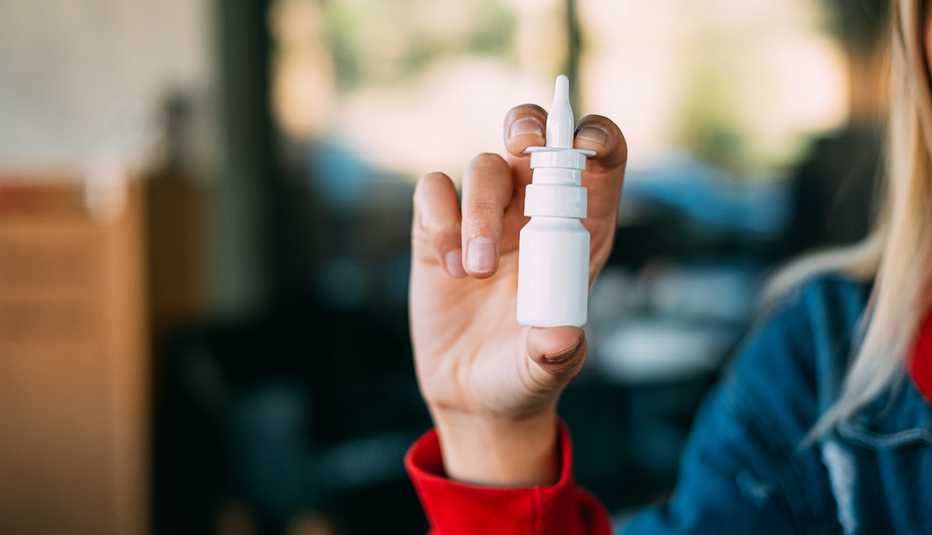AARP Hearing Center


For more than 81 million Americans, a new season also means the start of allergy symptoms. The result of an overly sensitive immune system, seasonal allergies can range from pesky to debilitating.
Allergies are your immune system’s response to a foreign substance, or allergen. Seasonal allergies, sometimes referred to as hay fever or allergic rhinitis, are your body’s attempt to expel a harmless substance that your immune system has mistakenly identified as dangerous. When this happens, your body overreacts and produces antibodies that “attack” the allergen. This can cause coughing, wheezing, itching, hives, rash, runny nose, and watery or itchy eyes. In severe cases, it can cause breathing trouble, asthma attacks, low blood pressure and anaphylaxis — a potentially life-threatening allergic reaction.
The good news: Allergies are treatable. Understanding your symptoms — and how to choose the right allergy regimen for you, including over-the-counter meds and simple lifestyle tweaks — is the first step toward a better allergy season. Below, we provide allergist- and research-backed ways to stave off seasonal allergy symptoms — and what’s best to avoid.


THE BASICS
1. Identify your allergens
Triggers to seasonal — or environmental — allergens include pollen, grasses and ragweed. You could also be allergic to mold, pet dander, cockroach droppings and dust mites. Identifying what you’re allergic to can help you keep symptoms at bay. Seasons and weather can affect allergic responses, but not always. In most regions, tree and grass pollen are prevalent in spring and summer, and ragweed is high in summer and fall. If you live in a hot, dry climate where trees pollinate all year, you might have winter allergies too. If you want to be sure, talk to an allergist about a skin prick or blood test to identify your allergens.
2. It’s not just itchy eyes and a runny nose
The allergic response can cause other, lesser-known symptoms. Increased mucus production — your body’s defense against allergens — can result in postnasal drip and cough. “The mucus can trigger a cough receptor in the back of your throat, or you might cough if you inhale an irritant,” says Margee Louisias, M.D., an allergist and immunologist and instructor at Harvard Medical School. For many, congestion results in sinus headaches that feel like pressure in your face.
3. Older people may have atypical symptoms
Your allergy symptoms might change as you get older. You may not even realize your symptoms are from allergies. Older people commonly experience generalized skin itching, rather than just itchy, watery eyes. You could feel more fatigued than normal or experience a heavy-headed feeling some people describe as “brain fog.” “Sometimes older people feel fluish or feverish, but there’s no actual fever,” says Sherwin Hariri, M.D., a board-certified allergist and immunologist, clinical instructor at the UCLA Department of Medicine and medical director at Beverly Hills Allergy. If you develop a fever, check in with your doctor, because you may have an infection.
4. Allergies can develop any time
You can develop new seasonal allergies at any time, says R. Sharon Chinthrajah, M.D., an allergist and immunologist with Stanford Health Care. Experts aren’t totally sure why, she says, but diet, viral infections, pregnancy and lifestyle changes may contribute. The hormonal changes that occur with menopause can also impact the immune system and cause new-onset or worsening allergies, Hariri says.
5. Climate change = more allergy symptoms
Additionally, climate change can affect allergies. One 2022 study projects allergy season will start sooner and last longer as global temperatures increase. Pollen data in the San Francisco area also found temperature increases to coincide with longer pollen seasons. According to Chinthrajah, these findings suggest climate change is likely to cause allergy symptoms to last longer, but it’s not clear yet whether allergens themselves will cause increased severity. “There have been several studies over the last few years that are predicting, using advanced modeling, that our pollen seasons are going to continually get longer,” says Zachary E. Rubin, M.D., a pediatrician specializing in allergy treatment and immunology. “So if you look back over the last 20 to 30 years, depending on where you live, the pollen season has been about two weeks longer on average. Climate change is a real phenomenon.”
6. Allergies can change as we age
Our immune systems can weaken as we age, leading to intolerance for allergens we once could handle. “A lot of these allergic diseases start out in early childhood — whether it’s eczema, food allergy, allergic rhinitis, asthma, any of those types of things typically crop up in the early stages of life,” Rubin says. “And they can get better over time for some people; for others, it can get worse. And then there’s other people in adulthood, where it crops up all of a sudden.”
7. It might not be allergies
The anatomy of nasal passages and sinuses changes with age as well, resulting in more mucus production. This can lead to a watery, runny nose — but it’s not allergies, Rubin notes: “That’s not an allergic process, it’s a nonallergic process, and so it’s treated differently.” Nonallergic rhinitis is due to other triggers that can cause other forms of inflammation such as pollutants, fragrances, tobacco smoke and changes in weather. Nasal passages can become more prone to producing mucus with age, and the immune system functions differently over time, so rhinitis can occur without allergic triggers.
8. It could actually just be a cold
Allergies and viral infections such as the common cold, the flu or COVID-19 share symptoms — including respiratory issues, fatigue and general malaise — so you may wonder which you’re suffering from. Fever, says Louisias, is the main differentiator: “If you have chills or your temperature is elevated, that’s not allergies.” Body aches are more commonly a sign of infection. Viral illness also won’t improve when you take an antihistamine. Studies also find allergic inflammation can make people susceptible to viral illness, so treating your seasonal allergies could protect you from sickness.
9. It’s probably not a food allergy
“A lot of people think that things like milk may worsen allergies … and that may be true, we just don’t have a lot of good, hard evidence to say that that’s definitely true,” Rubin says. However, “we do know that hot and spicy foods typically make people’s noses run — it’s something called gustatory rhinitis,” he says. This response is a type of nonallergic rhinitis, where your nose gets inflammation but not because of an allergy and with no obvious cause. If it’s really bothersome, talk to your doctor about medication to treat it, Rubin adds: “Our relationship with food is quite complicated. I think a lot of people blame food for a lot of things, when that may not be something that we can actually prove. There’s so many of these bogus food sensitivity tests that are out there that don’t really give any clinical benefit for people. And they just are expensive and potentially harmful.”
10. Allergies can be genetic
“In families where one parent has allergies, typically their kids are at higher risk of developing allergies,” Rubin says. “A lot of these processes are multifactorial when it comes in, and this is true of pretty much most chronic diseases. If you have some genetic predisposition and an environmental exposure, then the disease manifests.”
11. Don’t blame the city planners
Male trees have long been preferred for planting because they have no seeds or pods to drop. While this results in less cleanup and yard work, the trees do produce pollen, leading some on social media to call out city planners. “You may have heard a lot of people talk on social media about this idea of botanical sexism — where a lot of major cities planted male trees because they didn’t want to deal with the fruit that was going on the streets,” Rubin says. This, many noted in their posts, was why the pollen count was so high in your neighborhood. But that’s not the whole picture. “There’s a lot more pollen now in general, but to say that that’s directly because of that is a little bit misleading. It’s not the only reason why people are having worsened allergies,” Rubin says.
12. Pollen can travel far
“A lot of people think, Oh, do I need to cut down the tree that’s by my house to help with my allergies? [But] that doesn’t really help for the vast majority of people, because the pollen grains blow all over the place,” Rubin says. Pollen grains could be miles away, and in some cases even 100 miles away, he says. So removing one tree from your backyard won’t help at all.


HEALTH RISKS
13. Higher risk of infections
Treating allergies isn’t just for comfort. People with seasonal allergies are at a higher risk for sinusitis, a bacterial infection that can occur due to stagnant mucus, Rubin says: “If you have enough swelling [in your nasal passage], then secretions can become stagnant and allow for viruses and bacteria to thrive, leading to sinus infections.” Additionally, allergies are a known trigger for asthma flares in people who have it, and allergies can also cause asthma symptoms in people who may not have generalized asthma. If you experience shortness of breath, wheezing or severe cough, talk to a doctor about treating asthma along with your allergy symptoms.
14. Brain fog and sleep apnea
Because symptoms can disturb sleep, allergy sufferers often complain of fatigue, says Mark Moss, M.D., an allergist in Madison, Wisconsin, and director of the allergy and immunology clinical research program at the University of Wisconsin Medical School. Losing shut-eye can also cause cognitive difficulties — such as impaired attentiveness, concentration and focus — that some people call brain fog. “All of those have been shown to be affected adversely when people have worsening nasal allergies,” Moss says. People with sleep apnea might notice worsening symptoms if they have a stuffy nose, says Matthew C. Altman, M.D., associate professor of allergy and infectious diseases at the University of Washington Medical School. Plus, it’s hard to use a CPAP machine when air can’t properly flow through your nasal passages.



































































You Might Also Like
Tips for Great Eye Health
From what you eat to how your heart impacts your eyes, here are ways to protect your vision
How to Build Healthy Habits
These tips can help create changes that positively impact your well-being for years to come
Smart Guide to Oral Health
From how to brush your teeth to slowing enamel loss, we have tips to keep your mouth in good shape
Recommended for You